What Do People Eat During Carnival Around The World: 15 Specialties You Should Know
As the saying goes, during Carnival, every dish is fair game. We've gathered a selection of sweet and savory specialties from across Europe and beyond, perfect for adding a unique twist to your celebrations—all while indulging in delicious flavors.
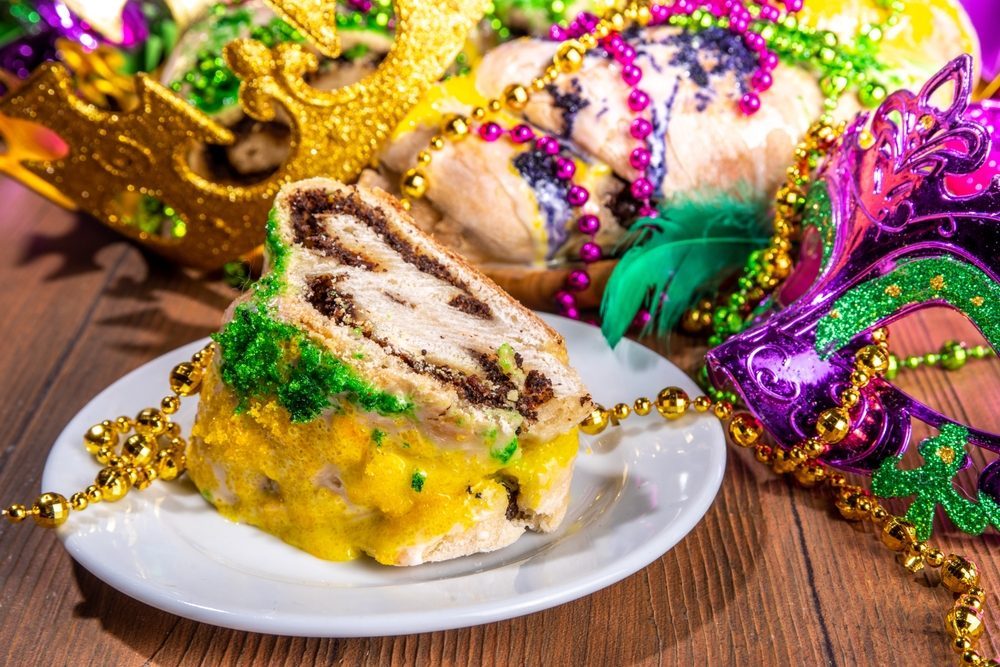;Resize,width=742;)
In the U.S., Mardi Gras is the ultimate Carnival celebration, and like any great festivity, food plays a major role. New Orleans is at the heart of it all, where people indulge in King Cake, a colorful, cinnamon-filled pastry topped with icing and sprinkles, often hiding a tiny plastic baby inside. But the U.S. isn’t the only place where food is central to Carnival—other countries have their own delicious traditions, too.
Many Carnival treats lean toward the sweet side, especially when fried dough is involved. In France, bugnes—light, crispy fritters dusted with powdered sugar—are a favorite. Spain keeps it classic with churros, often dipped in rich hot chocolate. In Germany, you’ll find Berliners, jelly-filled doughnuts similar to American jelly doughnuts. Meanwhile, Belgium serves up smoutebollen, fluffy fried dough balls filled with apples or raisins.
The United Kingdom takes a slightly different approach, dedicating an entire day to pancakes on Shrove Tuesday. Families whip up stacks of thin, crepe-like pancakes served with sugar and lemon or syrup, keeping the tradition alive year after year.
Beyond Europe, Carnival is just as indulgent. In Brazil, where celebrations are larger than life, food takes center stage with feijoada, a rich, slow-cooked black bean and pork stew that’s a national favorite. Over in the Caribbean, Carnival is all about bold flavors, with dishes like doubles in Trinidad and Tobago—curried chickpeas stuffed inside soft, fried flatbreads.
If you’re looking to bring new flavors to your own Carnival celebrations this year, take inspiration from these global traditions. Whether it’s a sweet treat like King Cake or a hearty dish like feijoada, there’s no shortage of ways to indulge in the spirit of Mardi Gras—wherever you are!
1. Bugnes (France)
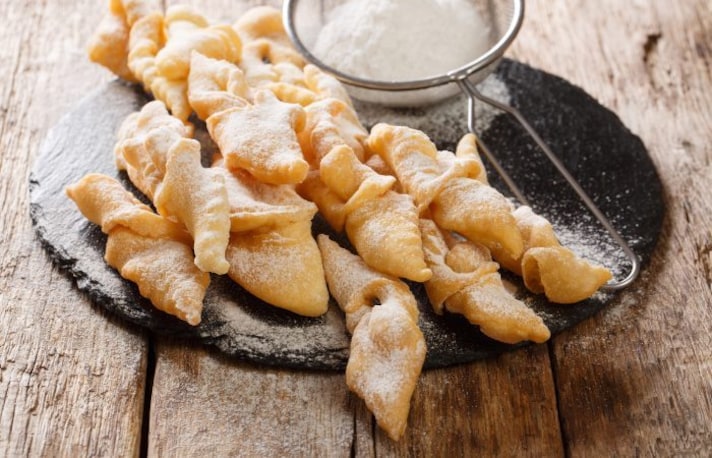
We begin the tour in France, a country where the Carnival tradition is deeply felt: many cities are involved from North to South, some with characteristic celebrations, such as the very famous ones in Nice, or the UNESCO heritage of Granville, in Normandy. Among the most typical sweets that can be tasted are the bugnes, fritters especially widespread in the Lyon area, known by the name of Bugnes Lyonnaises: these are leavened sweets that can be more or less crunchy, with a dough that varies in consistency. They are often flavored with orange, vanilla, but also rum and are eaten sprinkled with granulated sugar.
2. Smoutebollen (Belgium)
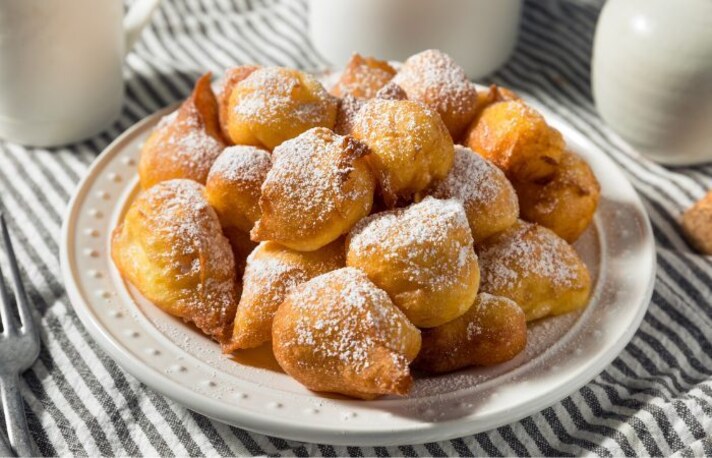
Carnival is also particularly loved in Belgium, where the most famous one is held in the city of Binche: declared a UNESCO heritage site in 2003, it sees hundreds (if not thousands) of people with wax masks parading through the streets dressed as Gilles, a folkloric character dating back to the 18th century, if not the 16th century, who dances and plays drums. To fill the stomach there are smoutebollen, soft and golden pancakes, similar to tortelli, enriched with raisins, apples or other fresh fruit, served with a sprinkling of icing sugar: they are a typical street food that you will find everywhere.
3. Berliner (Germany)
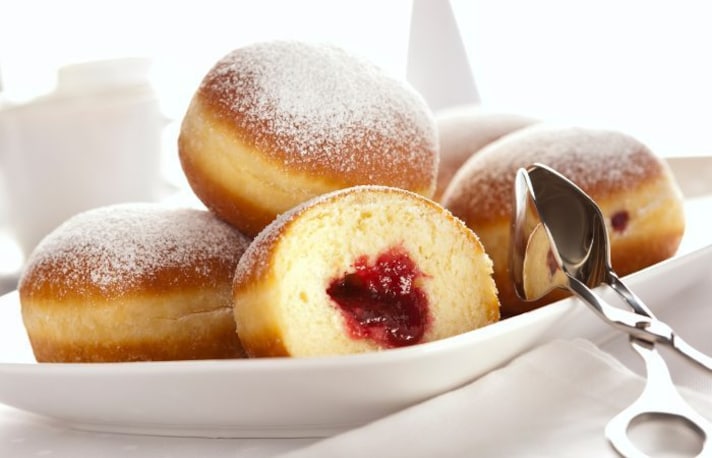
There is no German carnival worthy of respect without krapfen, delicious leavened dough brioches filled with apricot or raspberry jam and dusted with powdered sugar. In Germany they are popular under the name of Berliner Pfannkuchen, or more simply Berliner: although they are available all year round, they are among the protagonists of the celebrations of Rosenmontag, the Monday before Ash Wednesday and which marks the beginning of Lent: it is impossible for them to be missing from the stalls at the edges of the streets during the parades.
4. Semla (Sweden)
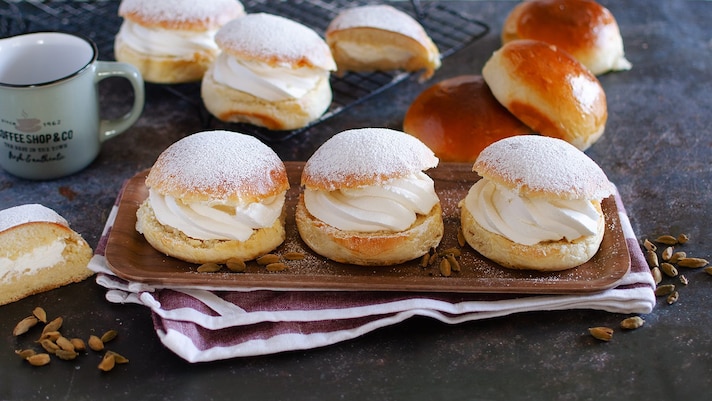
We land in Sweden (and in general in Scandinavian countries), where even though Carnival is less heartfelt it still includes a typical dessert, to be enjoyed on Shrove Tuesday: a last sin of gluttony before the long period of "penance" that precedes Easter. We are talking about semla, soft round rolls that date back to 1541: they are flavored with cardamom and stuffed with a tasty filling made with mandelmassa (which resembles almond paste) and whipped cream. How are they eaten? Traditionally they are accompanied by a cup of hot milk, but they also go well with tea or coffee.
5. Schenkeli (Switzerland)
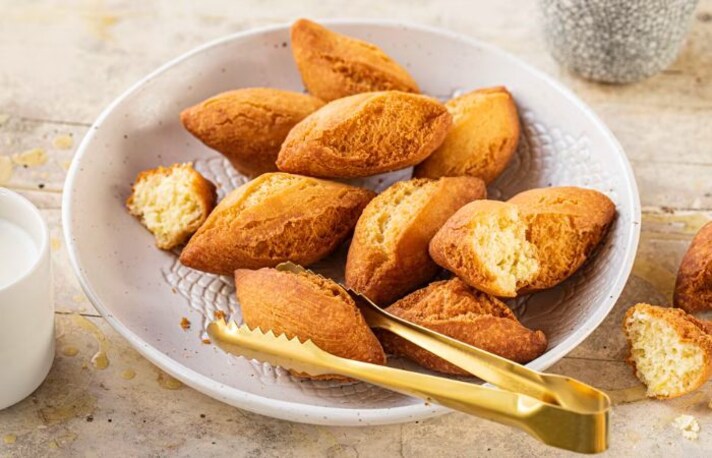
Schenkeli are fried Swiss sweets typical of Carnival: their name means "thighs" due to their tapered shape and for this reason they are also called "lady's thighs" or "lady's legs". The dough is made of butter, sugar, eggs, flour and yeast, flavoured with lemon zest and kirsch, the famous cherry distillate. After resting, the dough is shaped into small cylinders and fried in oil or lard until golden. The result? They are crispy on the outside and soft on the inside, perfect to enjoy with tea or coffee during the Basler Fasnacht, the great Basel Carnival.
6. Pancake (UK)
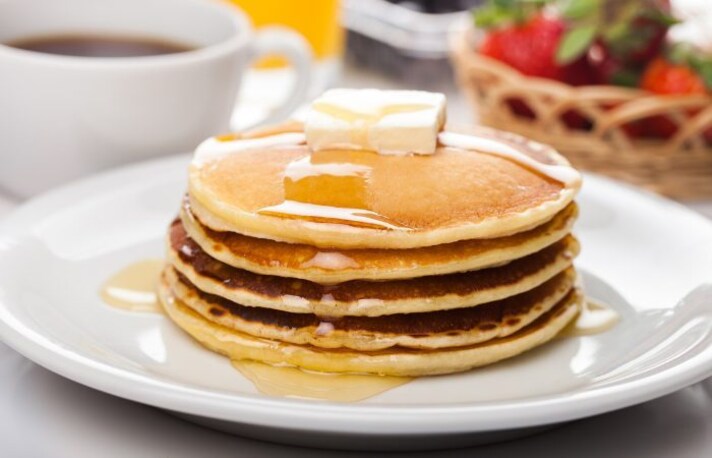
They are the typical pancakes of the Anglo-Saxon breakfast: in the United Kingdom they have a dedicated day, Pancake Day, which coincides with Shrove Tuesday. This tradition has medieval roots, when butter and eggs had to be consumed before the beginning of Lent, since they became prohibited ingredients. In London and other cities, fun Pancake Races are organized, competitions in which participants run with a frying pan in hand trying to pop the pancakes at least three times without dropping them.
7. Churros (Spain)
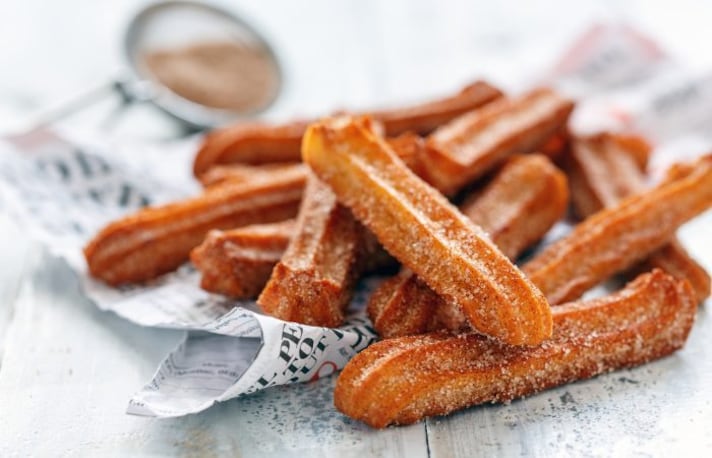
A true icon of Spanish street food, churros are the classic elongated fritters made with a dough similar to choux pastry and rolled in a mixture of sugar and cinnamon before being eaten while still hot, perhaps paired with jam or, even better, a cup of hot chocolate to dip them in. They can be found all year round, eaten for breakfast or as a snack, and therefore they can only make an appearance at Carnival, the most delicious celebration there is. The place to be in Spain? Cadiz, in the splendid Andalusia.
8. Bourekia (Cyprus)
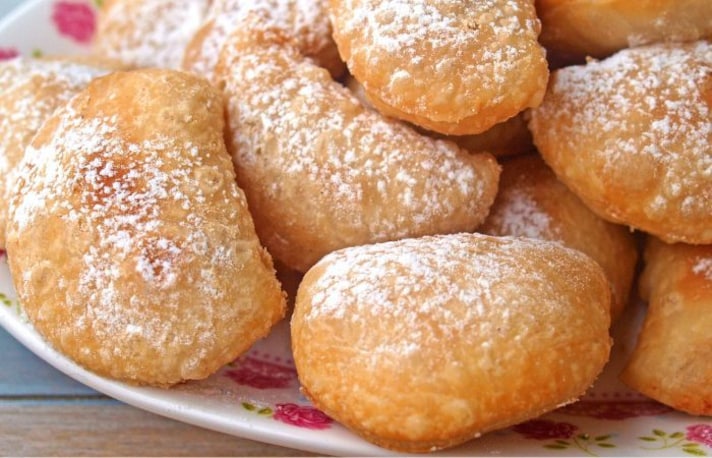
Here we are in Cyprus, where the Carnival celebrations last 10 days, as per Greek tradition: the most characteristic are those of the city of Limassol (or Lemesos), which in addition to being the largest on the island are also part of the UNESCO heritage, thanks to their mix of Byzantine and Venetian influences. Among the gastronomic specialties, worthy of mention are the bourekia, delicious fried dough parcels filled with sweetened local cheese and flavored with cinnamon: they are prepared at home and can also be bought on the street.
9. Blinis (Russia)
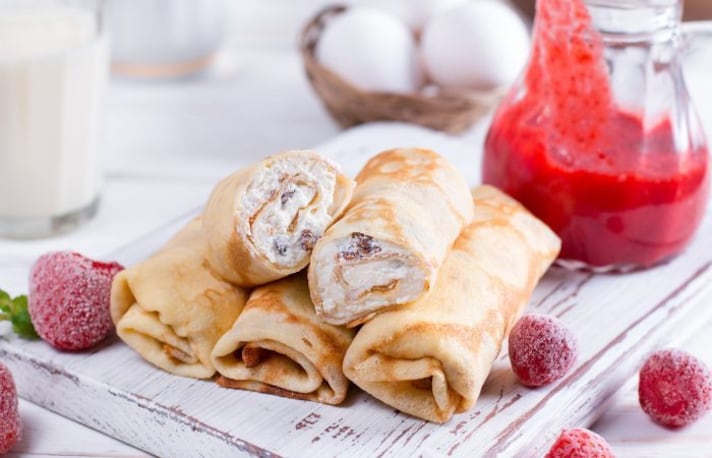
Blinis are thin pancakes of Russian origin, similar to crêpes, but slightly spongier, prepared with flour, milk, eggs and yeast, with versions that also contain water or yogurt. They are traditionally enjoyed during Maslenitsa, an Orthodox celebration similar to Carnival, with pagan origins, which celebrates the return of spring after winter: their disc-like shape, in fact, recalls the sun. They can be served both sweet, with honey or jam, or savory, with sour cream, salmon and caviar.
10. King Cake (U.S.)
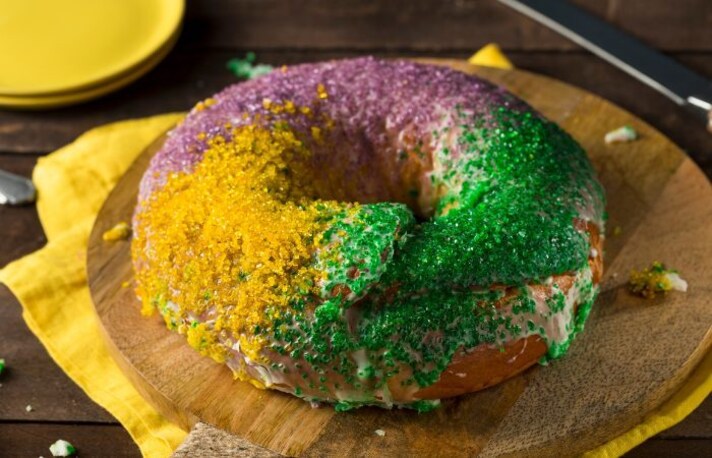
The symbolic dessert of our New Orleans Mardi Gras? Without a doubt the King cake, a donut decorated with purple, green and gold colored icing and sprinkles, which represent the official colors of this extraordinary Carnival, established in the 18th century and which attracts tourists from all over the world for its mix of cultures and lively parades. An essential element is precisely this scenic cake, which in philosophy recalls the galette de rois, since inside it often hides a little surprise.
11. Papos De Anjo (Brazil)
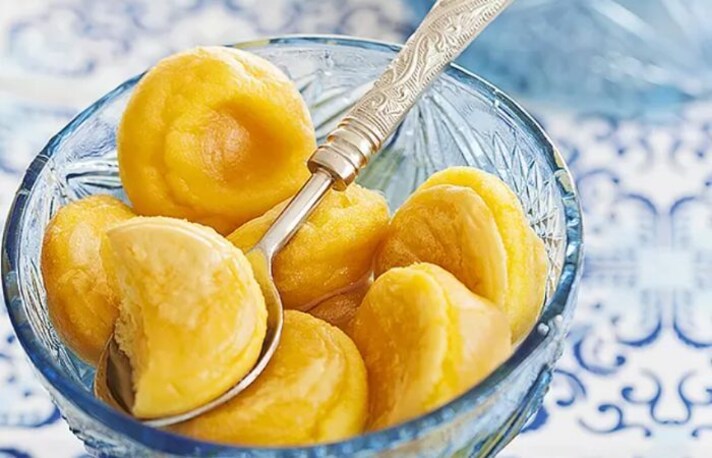
A recipe of Portuguese origin, brought to Brazil by the colonizers and which has become a classic of local pastry making: they are called papos de anjo (translatable as "angel's words") and are small sweets made from beaten egg yolks, cooked in muffin molds and then lightly boiled in sugar syrup, which can be flavored with rum, orange peel or vanilla. The Brazilian Carnival certainly needs no introduction, with the one in Rio invading the streets of the metropolis for days on end.
12. Feijoada (Brazil)
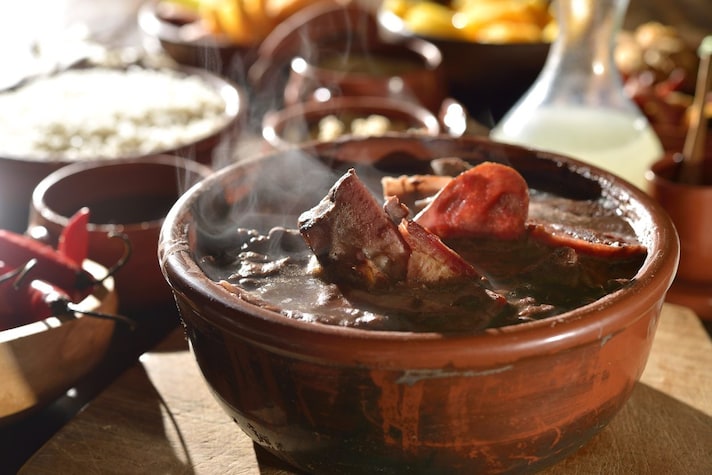
We remain in Brazil to introduce some savory recipes: here the feijoada, the famous Brazilian national dish, can only come into play . A rich and substantial preparation made with black beans and pork, served with vegetables, rice or farofa, which serves to give the body energy to sustain the wild dancing that continues well into the night.
13. Papona (Tenerife, Spain)
Also among the most sumptuous carnivals in the world is the one in Santa Cruz de Tenerife, in the splendid setting of the Canary Islands. Here, among parades of floats and the famous Gala de la Reina, the night in which the Carnival queen is elected, the papona appears: it is a large baked potato, cooked with the skin, which is hollowed out and stuffed with various ingredients. Traditionally, the filling includes tuna, sweet corn, diced cooked ham, olives and mayonnaise.
14. Corn Soup and Doubles (Trinidad and Tobago)
During the Carnival of Trinidad and Tobago, especially that of Port of Spain, among the most “exuberant” in the Caribbean, there are two typical dishes that stand out, corn soup and doubles. The first is a creamy soup made with fresh corn, coconut milk and spices, served hot in street stalls. The second, on the other hand, are fried rolls stuffed with chickpea curry and seasoned with mango chutney or spicy sauce. As with feijoada, in this case too they are perfect for recharging your batteries and being ready for the festivities of the following day.
15. Vepřo knedlo zelo (Czech Republic)
We conclude the dance by moving to the Czech Republic, where between February and March Masopust arrives, which means “giving up meat”. It is, therefore, the last chance before the Lenten period of abstinence to eat meat: the opportunity, in Prague and its surroundings, is seized on the fly to feast on vepřo knedlo zelo, a traditional dish that is made up of three parts: a sliced pork roast, large bread dumplings also sliced (knedlíky) and stewed sauerkraut. All possibly washed down with beer.
;Resize,width=767;)

;Resize,width=712;)
;Resize,width=712;)
